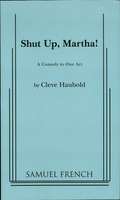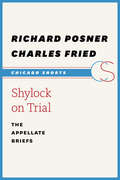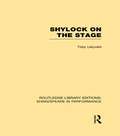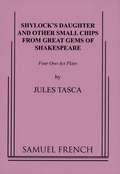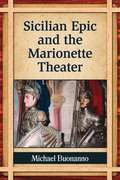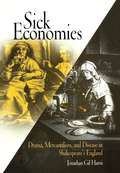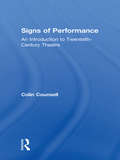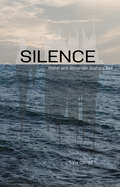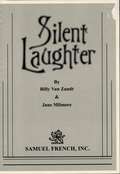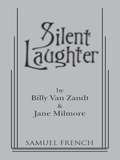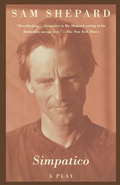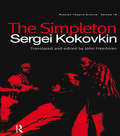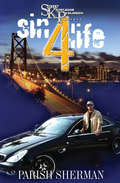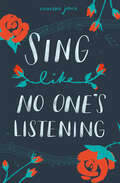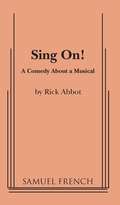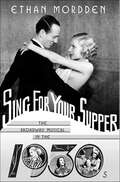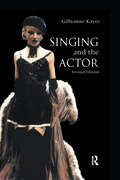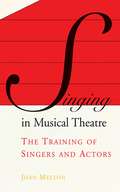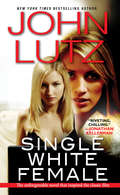- Table View
- List View
Shut Up, Martha!
by Cleve HauboldComedy / 3m, 2f / Interior / On a stormy night, a mysterious cloaked figure appears in Benjamin Franklin's print shop to insist Ben print a letter "to save the country." The fun and confusion build until the visitor produces a basket of chocolates and casts off her disguise to reveal herself as Martha Washington. Wild eyed Martha plies the wary Ben with promises and peanut brittle to persuade him to publish her note in which she sees a Tory behind every tree. Ben tries to calm Martha, but she becomes a whirlwind of confusion, when George Washington himself angrily arrives to drag Martha back to Mount Vernon. A mad historical romp which shows how history can repeat itself.
Shylock on Trial: The Appellate Briefs
by Charles Fried Richard PosnerWilliam Shakespeare is inextricably linked with the law, his plays rich in its terms, settings, and thought processes. In Shylock on Trial: The Appellate Briefs, the Hon. Richard A. Posner and Charles Fried rule on Shakespeare's classic drama The Merchant of Venice. Framed as a decision argued by two appellate judges of the period in a trial following Shylock's sentencing by the Duke of Venice, these essays playfully walk the line between law and culture, dissecting the alleged legal inconsistencies of Shylock's trial while engaging in an artful reading of the play itself. The resultant opinions shed fresh light on the relationship between literary and legal scholarship, demonstrating how Shakespeare's thinking about legal concepts and legal practice points to a deep and sometimes vexed engagement with the law's technical workings, its underlying premises, and its social effects.
Shylock on the Stage (Routledge Library Editions: Shakespeare in Performance)
by Toby LelyveldOriginally published in 1961, this book is a study of the ways actors since the time of Shakespeare have portrayed the character of Shylock. A pioneering work in the study of performance history as well as in the portrayal of Jews in English literature. Specifically it studies Charles Macklin, Edmund Kean, Edwin Booth, Henry Irving and more recent performers.
Shylock's Daughter and Other Small Chips from Great Gems of Shak
by Jules TascaA fresh twist on characters from Shakespeare’s classics. Contensts (Click for descriptions.) Shylock’s Daughter Prince Lear The MacDuff Tragedy Friar Falstaff
Sicilian Epic and the Marionette Theater
by Michael BuonannoThis study analyzes the folkloric genres that comprise the repertoire of the marionette theater in Sicily. Here, epic, farce, saints' lives, bandits' lives, fairytales, Christian myth, and city legend offer the vehicles by which puppeteers comment upon, critique--perhaps even negotiate--the relationships among the major classes of Sicilian society: the aristocracy, the people, the clergy and the Mafia. The lynchpin of the repertoire is the Carolingian Cycle and, in particular, a contemporary version of The Song of Roland known in Sicily as The Death of the Paladins, a text which illustrates the means by which the Carolingian heroes--Charlemagne, Roland, Renaud, Ganelon, and Angelica--augment saints, bandits, Biblical figures and Sicilian folk heroes to provide the marionette theater its rhetorical function: the articulation and dissemination of the tools of Sicilian identity.
Sick Economies: Drama, Mercantilism, and Disease in Shakespeare's England
by Jonathan Gil HarrisFrom French Physiocrat theories of the blood-like circulation of wealth to Adam Smith's "invisible hand" of the market, the body has played a crucial role in Western perceptions of the economic. In Renaissance culture, however, the dominant bodily metaphors for national wealth and economy were derived from the relatively new language of infectious disease. Whereas traditional Galenic medicine had understood illness as a state of imbalance within the body, early modern writers increasingly reimagined disease as an invasive foreign agent. The rapid rise of global trade in the sixteenth century, and the resulting migrations of people, money, and commodities across national borders, contributed to this growing pathologization of the foreign; conversely, the new trade-inflected vocabularies of disease helped writers to represent the contours of national and global economies.Grounded in scrupulous analyses of cultural and economic history, Sick Economies: Drama, Mercantilism, and Disease in Shakespeare's England teases out the double helix of the pathological and the economic in two seemingly disparate spheres of early modern textual production: drama and mercantilist writing. Of particular interest to this study are the ways English playwrights, such as Shakespeare, Jonson, Heywood, Massinger, and Middleton, and mercantilists, such as Malynes, Milles, Misselden, and Mun, rooted their conceptions of national economy in the language of disease. Some of these diseases—syphilis, taint, canker, plague, hepatitis—have subsequently lost their economic connotations; others—most notably consumption—remain integral to the modern economic lexicon but have by and large shed their pathological senses.Breaking new ground by analyzing English mercantilism primarily as a discursive rather than an ideological or economic system, Sick Economies provides a compelling history of how, even in our own time, defenses of transnational economy have paradoxically pathologized the foreign. In the process, Jonathan Gil Harris argues that what we now regard as the discrete sphere of the economic cannot be disentangled from seemingly unrelated domains of Renaissance culture, especially medicine and the theater.
Sight Unseen and Other Plays
by Donald MarguliesIncludes: Found a Peanut, The Loman Family Picnic, The Model Apartment, What's Wrong with This Picture?, and Sight Unseen.. With a palpable affection for the traditions of the stage and a taste for surreal comedy, Margulies "manages to transform what might have been kitchen-sink drama into theatre that is unsettling, imaginative and quite hilarious"--Howard Kissel, New York Daily News
Sightlines
by Rage Theatre ProductionsEvery three years, over the last decade, the Mumbai-based theatre group RAGE - in collaboration with the Royal Court Theatre in London - organizes the Writers' Bloc Workshop. Offering a much-needed artistic retreat to playwrights, this workshop allows aspiring and professional playwrights a chance to perfect their scripts with established actors and professionals from within the industry. Apart from encouraging them to break free from the rigid boundaries of English theatre in India to fashion their own idiom, the workshop also ensures its playwrights access to the final pilgrimage of any script - the stage. As it stands today, the infamous debate on whether an Indian play written in English mirrors a bona fide Indian reality is no longer relevant. Using a vocabulary that is entirely their own - 'unaffected, homegrown and lyrical' - the three plays in this collection convincingly capture the peculiar accents and the particular chaos of our times. Rahul Da Cunha's 'Pune Highway' is set in a seedy hotel room where three friends, having just witnessed the gruesome murder of a fourth, are holed up, desperate to escape its consequences; Ram Ganesh Kamatham's 'Crab' takes a hard-talking look at the existential angst of a new generation, looking at once for purpose and an emotional safe place from an increasingly concrete world; Farhad Sorabjee's 'Hard Places' explores the unspoken borders that divide us from our loved ones and the violently disputed borders between countries. Bridging the invisible lines between the personal and the political and taking us to places and situations a little less familiar and safer than our own, these brilliantly written plays can be performed, and empathized with, across territories.
Signs of Life: Six Comedies of Menace
by Joan M. SchenkarJoan Schenkar, widely regarded as America's most original female contemporary playwright, is the author of numerous experimental plays which she refers to as "comedies of menace." Bristling with wit and intelligence, the collection features Signs of Life, Cabin Fever, The Universal Wolf, Burning Desires, The Last of Hitler, and Fulfilling Koch's Postulate. These plays explore issues of feminism and gender politics, history and memory, sexuality and violence, bringing to life such figures as Gertrude Stein and Marlene Dietrich, Hitler and Eva Braun, P. T. Barnum and Henry and Alice James, Claude Levi-Strauss and Roland Barthes. Schenkar's charged language and evocative stage directions invite the reader to become both performer and audience, and the experience is enhanced both by richly evocative stage directions and illustrations from productions of the plays. Initially written to be read like novels as well as staged, the plays provide a unique theatrical experience, an experience that can only be accessed by laughter.
Signs of Performance: An Introduction to Twentieth-Century Theatre
by Colin CounsellSigns of Performance provides the beginning student with working examples of theatrical analysis. Its range covers the whole of twentieth century theatre, from Stanislavski to Brecht and Samuel Beckett to Robert Wilson. Colin Counsell takes an historical look at theatre as a cultural practice, clearly tracing connections between: * Key practitioners' ideas about performance * The theatrical practices prompted by those ideas * The resulting signs which emerge in performance * The meanings and political consequences of those signs It provides an understandable theoretical framework for the study of theatre as a an signifying practice, and offers vivid explanations in clear, direct language. It opens up this fascinating field to a broad audience.
Sila: The Arctic Cycle
by Chantal BilodeauIn Inuit mythology, "sila" means air, climate, or breath. Bilodeau's play of the same name examines the competing interests shaping the future of the Canadian Arctic and local Inuit population. <P><P>Equal parts Inuit myth and contemporary Arctic policy, the play Sila features puppetry, spoken-word poetry, and three different languages (English, French, and Inuktitut). There is more afoot in the Arctic than one might think. On Baffin Island in the territory of Nunavut, eight characters - including a climatologist, an Inuit activist and her daughter, and two polar bears - find their values challenged as they grapple with a rapidly changing environment and world. Sila captures the fragility of life and the interconnectedness of lives, both human and animal, and reveals in gleaming tones that telling the stories of everyday challenges - especially raising children and maintaining family ties - is always more powerful than reciting facts and figures. Our changing climate will have a significant impact on how we organize ourselves. Nowhere is this more apparent than in the Arctic, where warming temperatures are displacing entire ecosystems. The Arctic Cycle - eight plays that examine the impact of climate change on the eight countries of the Arctic - poignantly addresses this issue. Sila is the first play of The Arctic Cycle. With its large-as-life polar bear puppets, the play is evocative and mesmerizing, beautifully blurring the boundaries between folklore and science.
Silence: Mabel and Alexander Graham Bell
by Trina DaviesIt only takes one spark of love to change the world forever. Mabel Hubbard Bell was a strong, self-assured woman—bright, passionate, and a complete original. Despite a near-fatal case of childhood scarlet fever that cost her the ability to hear, she learned to talk and lip-read in multiple languages. At nineteen, she married a young inventor named Alexander Graham Bell and became the most significant influence in his life. This is Mabel's story, offering the unique perspective of a woman whose remarkable life was forever connected to her famous, distracted husband. From inspiring invention to promoting public service, Mabel and Alec challenged each other to become strong forces for good. Silence is a beautiful and true love story about how we communicate.
Silent Laughter
by Jane Milmore Billy Van ZandtComedy / 8m, 2f / New York audiences went wild for this gag-filled water sloshing, bed crashing, pie throwing craziness. Performed in black and white with title cards projected over the actors' heads, and a live theatre organ accompanying every doubletake, this comic tour de force stars a dashing hero who overcomes jail, poverty, World War I and a dastardly villain, Lionel Drippinwithit, to win the girl of his dreams. She is the heiress to the Thickwad Screw Factory, a firm that has been "Screwing the American Public since 1861." The biggest pie fight the theatre world has ever seen caps the silent action. More than a tribute to the slapstick antics of Chaplin, Keaton and Arbuckle - this is a reverential recreation of a bygone era.
Silent Laughter
by Billy Van ZandtComedy \ 8m, 2f \ Various sets with projections \ New York audiences went wild for this gag-filled water sloshing, bed crashing, pie throwing craziness. Performed in black and white with title cards projected over the actors' heads, and a live theatre organ accompanying every doubletake, this comic tour de force stars a dashing hero who overcomes jail, poverty, World War I and a dastardly villain, Lionel Drippinwithit, to win the girl of his dreams. She is the heiress to the Thickwad Screw Factory, a firm that has been "Screwing the American Public since 1861." The biggest pie fight the theatre world has ever seen caps the silent action. More than a tribute to the slapstick antics of Chaplin, Keaton and Arbuckle - this is a reverential recreation of a bygone era. \ "Hilarious! . . . Surprises abound in the inspired physical comedy." - Village Voice
Simone, Half and Half
by Christine RodriguezFourteen-year-old Simone is caught between cultures: Canadian, Québécois, and Trinidadian. She’s also torn between friends and the projects they want her to take part in. Her best friend Sarah wants them to compete in the talent show with a dance routine, but her new friend Jay has introduced her to the Black History and Culture Committee’s activism and its organizer, tenth-grader Vanessa. Though Sarah represents the comfort of what she knew growing up, Jay and Vanessa offer Simone an opportunity to get to know part of herself that she hasn’t explored yet. As pressure mounts on seeing both projects through, her friendships start to feel the strain and her loyalties are tested. Can Simone find the courage to stand up for what she believes in? Will her friends accept the choices she makes? And will she finally learn to be more comfortable with herself? Simone, Half and Half is a touching story about finding one’s place between identities and communities.
Simpatico
by Sam ShepardSet within the netherworld of thoroughbred racing, this hair-raisingly funny new play by the Pulitzer Prize-winning author of True West explores the classical themes of memory, loyalty, and restitution. Simpatico launches readers into regions where high society meets the low life, and where, as one of the main characters observes, "someone is cutting someone else's throat."From the Trade Paperback edition.
Simpleton The (Russian Theatre Archive Ser. #Vol. 19.)
by Sergei KokovkinFirst Published in 2000. Routledge is an imprint of Taylor & Francis, an informa company.
Sin, Sex & The CIA
by Michael ParkerFull Length, Comedy . Characters: 3 male, 4 female . Huge oil reserves have been discovered in the Chagos Islands. O.P.E.C. is pressuring the Chagosians to join the cartel. A C.I.A. agent and an under Secretary of State, whose life appears to be run by her libido, are sent to a C.I.A. safe house in the mountains of Virginia to begin negotiations for the U.S. to place the Chagos Islands under their protection. Unfortunately, no one knows who the islands' representative really is. We are left to wonder how the C.I.A. agent ever got the job. He gets caught in all his own booby traps, he electrocutes himself, he sets fire to himself, he gets a bucket stuck on his head, and finally locks himself in his own handcuffs! Add to the inevitable chaos, a stranded televangelist, his innocent secretary (or is she?), an ex-marine caretaker, who isn't what he seems to be, and a mysterious, glamorous neighbor, and you have a complex, laugh out loud farce, that can be played on any stage.
Sin4Life
by Parish ShermanSimian Michaels better as Sin, hailing from the streets of East Oakland, the deadliest city in Northern Cali has just been released after serving a four year bid in a Georgia state prison. Upon touching down in the city he grew up in, Sin is faced with starting all over. Sin's girl before he was convicted ran off with his stash and left him for dead. He's on a mission to regain his status in the game with the help of his Mad Circle clique and his real potna from the joint. Shaunte' is in the streets getting paper like it is legal. She's a straight dime who's tired of the same ol' cats. Shaunte's beautiful looks are where people get it twisted with her. Tay as she's known to her inner circle is a cold blooded killer. She and Sin meet each other on some booty call time, but unforseen events make them much more. Tay is just what Sin needs, a Bonnie to his Clyde. From day one she shows Sin how a real"Down as Bitch" carries it, with and for her man. Parish Sherman takes readers on a fast paced journey through the streets of Oakland. From sex, to money, to murder, see how everyday hustling goes when you have somebody as determined as Sin out to get money, by any means neccessary. Street Knowledge, So Real You Think You Lived It!
Sing Like No One's Listening
by Vanessa JonesNettie Delany has just been accepted into a cutthroat performing arts school, but she hasn't been able to sing a single note since her mother died.Duke's Academy of Performing Arts isn't for the weak-willed or easily intimidated; the school has mentored plenty of big names, including Nettie's own mother—a ballerina superstar. With the shadow of grief haunting her every step, Nettie has her work cut out for her if she plans to stay enrolled in a highly coveted program.No room for error. Nettie must work through the pain of the past, horrible classmates, and vicious teachers to find her voice again and deliver a showstopper. If not, she faces expulsion. With the help of her friends and a new romance, can Nettie get it together in time? Everyone is watching.Former West End performer and author Vanessa Jones delivers a well-crafted journey of grief and healing in this contemporary young adult novel. An ideal read for fans of theater and Broadway musicals.
Sing On!
by Rick Abbot4m, 7f / Comedy about a Musical / Here by popular demand is the sequel to PLAY ON!. The gang is joined by Phyllis's song-writing nephew Monte when dire circumstances - their theatre in in peril - force them to do yet another show by Phyllis. The intrepid thepians know disaster will probably result: It may be tough to act on a sinking ship but can you sing as the waters rise! If you have never produced PLAY ON! - fear not. SING ON! stands on its own as a side-spitting encounter with a harried community theatre group. The music does not require a cast that can sing well, and the melodies (but not the lyrics) are well-known tunes by Stephen Foster. Everyone will have the time of their lives doing this melodious and absolutely lunatic catastrophe!
Sing for Your Supper: The Broadway Musical in the 1930s
by Ethan Mordden“[Mordden] excels at delineating the contrasting styles and personalities [of] Broadway’s busiest—and in showbiz terms, best—songsmiths of the 1930s.” ―Richmond Times-DispatchIn the 1930s, Broadway's lights still burned brightly. Ethan Mordden completes his history of the Broadway musical by taking a look at this forgotten era. Shows like Anything Goes brought the glitter of Cole Porter and Merman's brass to the public. Innovations in dance were pioneered by Balanchine and others. Scenic advancements made Astaire's The Band Wagon move across the stage in novel ways. Gershwin's revolutionary Porgy and Bess entered the canon of American Classics. And The Cradle Will Rock and Johnny Johnson took the American political temperature. With his trademark wit and style, Ethan Mordden shines the spotlight on Broadway's forgotten decade.“Mordden is an encyclopedia of knowledge about the Broadway musical. Fortunately, his information is so well organized and his conversational writing style so smooth that this tome never feels like a mere onslaught of facts. Those who are devoted to musical theater will love this comprehensive historical look.” —Publishers Weekly“Ever the enthusiastic aficionado, Mordden ferrets out the fascinating moments and important details of this period . . . invaluable.” ―Booklist
Singing and the Actor (Ballet, Dance, Opera And Music Ser.)
by Gillyanne KayesSinging and the Actor takes the reader step by step through a practical training programme relevant to the modern singing actor and dancer. A variety of contemporary voice qualities including Belting and Twang are explained, with excercises for each topic.
Singing in Musical Theatre: The Training of Singers and Actors
by Joan Melton Angela Punch McgregorWhat does it take to be a musical theatre performer? What kind of training is required to do eight shows a weekacting, dancing, and singing in a wide variety of vocal styles? This insider's look into the unique demands of musical theatre performance establishes connecting links between voice training for the singer and drama school training for the actor. By reading these revealing interviews, performers in every area of theatre can: - Discover what it takes to go from a first lesson to a solid professional technique Consider the requirements for singers in musical theatre today, how they have changed, and where they are going - See how different teachers approach six aspects of voice training: alignment, breathing, range resonance, articulation, and connection Understand the interconnectedness of musical theatre and theatre voice. A foreword by leading Australian actor Angela Punch McGregor personalizes the connective links among trainings as she describes her preparation for Sunset Boulevard. A must-read for anyone who is serious about voice and the theatre.
Single White Female
by John LutzNo matter how much you think you know, you're taking a chance when you shop for a new roommate. But after Allie Jones throws out Sam, her sexy but two- timing live-in lover, she desperately needs someone to split the rent on her Upper West Side New York apartment. And if anybody seems a safe bet, it's shy and unimposing Hedra Carlson, the least likely candidate for leaving dirty socks on the floor. Yet there is something odd about the way Hedra openly envies Allie's appearance and lifestyle. Then Allie begins receiving obscene phone calls from strangers who know her name; her credit cards mysteriously disappear; and she is shocked to discover that Hedra's wardrobe is eerily similar to her own. Unknown to Allie, her plain and modest roommate is sharing much more than the rent...and an unspeakable, bloody nightmare is just beginning...
